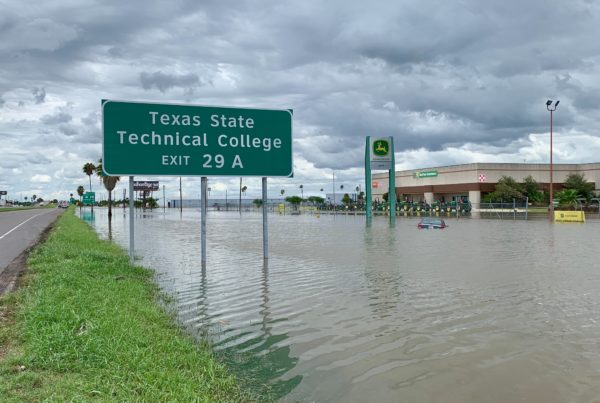In 2017, Texas lawmakers approved $300 million to begin an extensive revamp of the state hospital system. It’s a network of 10 hospitals that house kids and adults in need of inpatient psychiatric care.
Now, two years later, the state legislature has approved millions more to begin construction. But what is the actual plan? How will the money be spent? And how do we know if it will help the people who need it the most: the patients.
It’s no secret that Texas state psychiatric hospitals need a lot of work. Just ask Jim Pearson.
“We had a water main break a few years ago and when our maintenance crew dug down to replace it, the last time that pipe was fabricated was in 1911,” Pearson says.
Pearson works at Austin State Hospital and represents its staff in the Texas State Employees Union. Pearson says the out-of-date facilities aren’t just frustrating for employees to work in, but they also have an effect on patients.
“Imagine working with 20 or 30 people that are experiencing different symptoms of mental illness in a large dayroom. … It’s loud, it’s difficult sometimes to think,” Pearson says.
Many of Austin State Hospital’s buildings were built in the 1950s, and some are even older. Pearson says they aren’t set up for today’s technology.
“Any computer linkage, anything to do with … upgraded communication devices … have had to be rewired and retrofitted on a grid that, quite frankly, was never built to accommodate that,” he says.
Austin State Hospital is one of 10 hospitals across Texas, that are each in a different state of disrepair. But Texas has pledged to change that. Its comprehensive state hospital plan covers everything from better use of electronic records, to using more telemedicine. But better facilities are perhaps the biggest priority right now. That’s because many people experiencing a mental health crisis can’t get a bed, and they sit in jail waiting for one to open up. But Health and Human Services says about 650 more beds will become available once the plan is complete.
Central to the redesign of the whole system is Austin State Hospital. It sits on land in the middle of the capital city, and was the first hospital of its kind in Texas when it opened almost 160 years ago.
State Sen.. Kirk Watson and officials from UT-Austin’s Dell Medical School have touted it as the state’s new hub for so-called brain health. In other words, it’ll be a showpiece for the whole system. Kat Jones is Dell Medical’s lead designer.
“We wanted to not just reimagine a new modern hospital but go far beyond the building and say, ‘How does the system need to be redesigned?’ And then, What’s the hospital you design inside that system that’s way more forward thinking?” Jones says.
That redesign includes private rooms, better sight lines so nurses can see patients, and a variety of outdoor spaces. These are things Jones says would create a more healing environment. But before anything is built, Jones says designers focused first on what leads to a mental health crisis.
“We couldn’t find any sort of framework that says, ‘How do people live with this? What do they go through? What are the phases? What is their experience?” Jones says.
Jones and her team began diagramming the lifespan of a mental health condition looking hard at the moments before an individual reaches a crisis point.
“They either go to the ER or police are involved, or they may end up in jail, which is not the best place to be when you’re in a mental health crisis,” Jones says. “They may end up in an inpatient psychiatric hospital like the Austin State Hospital.”
People face mental health crises all over the state, which is why each of the state’s psychiatric hospitals cares for people in a particular region. Terrell State Hospital, located about 35 miles east of Dallas, services about 20 counties in northeast Texas. It too is in need of repair. Back in 2017, Sheila Kunick led a tour of the Terrell campus that sits just on the edge of town. The hospital opened in the 1880s but much has changed since then.
“In the early days … there were approximately 3,000 patients housed here,” Kunick says. “That’s why you see all these buildings that are now condemned and up for demolition. They lived everywhere here.”
Today, Terrell serves, at the most, 277 patients. Two years ago, a woman named Angela was one of them.
“Hi, my name’s Angela. I’m a 43-year-old educator and I’m comin’ to you from Dallas, Texas,” she says.
Angela, who lives with bipolar schizoaffective disorder, asked to be identified only by her first name to protect her job. Two years ago, after Angela had stopped taking her medication, she experienced a mental health crisis that landed her in the Dallas County Jail – something she had never experienced before. But while she was there, officers eventually realized that jail may have been the wrong place for her.
She was transferred to Terrell State Hospital and stayed there for two months. She says before that, she had heard scary rumors about the place.
“I would always hear things like … ‘Be careful, you don’t wanna go there, you don’t wanna go there.’ They made it sound like you were getting electrocuted or something … and it really was, so far, not like that,” Angela says.
Angela says the staff there stabilized her during a very difficult time in her life.
“They were more in tune to me than I was to myself. … They were patient in … giving me time to come back to myself,” She says.
Angela’s time at Terrell was step toward getting back on her feet. Now, more than a year later, she’s back at work and says she’s finally starting to rebuild her life.
Back in Austin, Kat Jones and her team are planning for construction to begin at Austin State Hospital. Health and Human Services Commission officials had asked the legislature for almost $283 million but they got just $165 million for the next two years. It’s a lot less, but Jones says she’s happy.
“It’s plenty for us to get started. … I mean, in a lot of ways, nothing’s really changed in terms of our plans. We are thrilled that we can begin to execute on the vision and begin construction,” Jones says.
Jim Pearson, the Austin State Hospital employee, says the rebuild is a start, but it won’t solve everything. He wanted lawmakers to raise the pay for 8,000 state hospital employees. He’s worried that even the fanciest new hospital won’t attract employees if wages don’t go up – and staff shortages affect the patients.
“We have a difficult time hiring direct care staff, we have a difficult time hiring clinicians, we have a difficult time hiring social workers. … It’s basically a moot point to talk about nice facilities and putting together a new hospital if you don’t have quality people that are able to man that hospital,” Pearson says.
But Pearsons’s fight isn’t over. The hospitals have some of the highest staff turnover of all state agencies, so his union is pushing the state to pay for “emergency” raises.
Support for Texas Standard’s ”Spotlight on Health” project is provided by St. David’s Foundation.
















